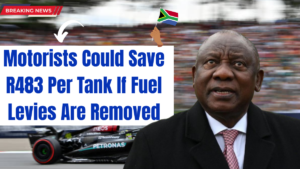In April 2025, South African fuel prices remain heavily burdened by taxes like the General Fuel Levy (GFL) and the Road Accident Fund (RAF) levy. According to a new analysis, these levies alone add between R272 and R483 to the cost of filling up a single tank, depending on the vehicle’s size.
At present, the GFL on petrol stands at R3.86 per litre, unchanged since the 2023/24 fiscal year. The RAF levy has also held steady at R2.18 per litre since 2021/22. With unleaded inland petrol priced at R21.61 per litre in April 2025, these two levies account for around 28% of the total per-litre cost.

Understanding how South Africa calculates petrol prices involves multiple components, including:
-
The Basic Fuel Price (BFP), which reflects the cost before taxes and levies
-
Wholesale and retail margins allowed for sellers
-
Transport and storage costs
-
Taxes like the GFL and the RAF levy
Based on these metrics, analysts have calculated how much motorists could potentially save if the GFL and RAF levies were scrapped entirely.
For instance, a 45-litre tank would cost R272 less to fill, while a 50-litre tank could save drivers R302. A large SUV or bakkie with an 80-litre tank would see a massive R483 reduction at the pump. Here’s a breakdown of the cost differences across various tank sizes:
Fuel Cost Comparison (with and without GFL and RAF – April 2025 Rates)
| Tank Size | Current Cost | Cost without Levies | Saving |
|---|---|---|---|
| 45 Litres | R972.90 | R701.10 | R271.80 |
| 50 Litres | R1,081.00 | R779.00 | R302.00 |
| 55 Litres | R1,189.10 | R856.90 | R332.20 |
| 60 Litres | R1,297.20 | R934.80 | R362.40 |
| 80 Litres | R1,729.60 | R1,246.40 | R483.20 |
Minister Mantashe Calls for a R14 Fuel Price
At the 2024 African Oil Week conference, South Africa’s Minister of Mineral and Petroleum Resources, Gwede Mantashe, stated that fuel in the country should realistically cost about R14 per litre. He pointed out that government-imposed levies have distorted the market, pushing fuel prices close to or above R20 per litre.
Mantashe stressed the need for a reformulated pricing structure that distinguishes between the base fuel cost and the attached levies. He added that the government aims to conclude discussions about lowering the fuel price formula in the near future.
Could Removing Levies Backfire? Experts Weigh In
While removing levies like the GFL and RAF would offer welcome relief for drivers, some economists warn of the broader consequences. Azar Jammine, chief economist at Econometrix, noted that removing the GFL could eliminate nearly 5% of South Africa’s annual government revenue, forcing reliance on other sources like income tax.
In July 2024, Jammine emphasized that political leaders might use fuel price cuts as a short-term solution to appease financially strained consumers. However, he warned that eliminating the GFL would create a large funding gap in the national budget.
Implications of Scrapping the RAF Levy
Eliminating the RAF levy could also lead to major policy changes. Experts suggest that its removal might necessitate mandatory third-party vehicle insurance for all drivers.
Rob Handfield-Jones, a road safety advocate and director at Driving.co.za, argued that the current RAF model is unsustainable. He noted that fatal road accidents have increased dramatically since the RAF’s inception, making the fund significantly underfinanced. He suggested that if the RAF levy were to reflect the real cost of traffic injuries and inflation, it would need to jump to R12–R15 per litre—an unrealistic burden for consumers.
Instead, Handfield-Jones recommends scrapping the levy and making comprehensive vehicle insurance a legal requirement. This, he argues, would shift financial responsibility from a public fund to individual drivers and insurers, potentially improving road safety standards and accountability.
Conclusion
The data shows that if levies were removed, South African motorists could enjoy significant savings at the pump. However, experts caution that eliminating these taxes would shift the financial burden elsewhere, potentially increasing other taxes or insurance obligations. The debate over how to balance relief for consumers with national financial stability continues, and any future changes will need to consider both economic and social impacts.
FAQs
How much of the petrol price is made up of taxes in South Africa?
About 28% of South Africa’s petrol price consists of the General Fuel Levy and the Road Accident Fund levy.
Will removing fuel levies make petrol cheaper?
es. If the GFL and RAF levies are removed, motorists could save between R272 and R483 per tank, depending on their vehicle’s tank size.
What are the risks of scrapping the GFL and RAF levies?
Removing these levies could reduce government revenue by around 5% and may result in increased income taxes or mandatory insurance policies.
Is it possible that the RAF levy could be replaced by third-party insurance?
Yes, some experts advocate for mandatory third-party insurance as a better alternative to the RAF levy, citing underfunding and inefficiency in the current system.
What does Minister Gwede Mantashe say about the petrol price?
Minister Mantashe believes that the true cost of fuel should be closer to R14 per litre and that levies are distorting the market price.
Click here to know more.
Aanchal is a passionate writer with a keen interest in storytelling, content creation, and creative expression. She enjoys exploring diverse topics and crafting engaging narratives that captivate readers.

